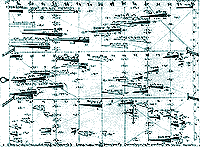In 1969 Zimmermann completed his Requiem for a Young Poet, dedicated to three writers who had committed suicide: Vladimir Mayakovsky (in 1930, at thirty-six), Sergei Esenin (in 1925, at thirty), and a young Austrian, Konrad Bayer (in 1964, at thirty-one), whose work the composer only came to know when the score was nearly finished. In the late spring of 1970, while Ich wandte mich was work-in-progress, the television director Horst Bienek asked Zimmermann to write a film score. The composer's terse reply indicating that he was "no longer available" came on a postcard with a photograph of Cesare Pavese (a suicide in 1950, shortly before his forty-second birthday); printed on the card were the first words of a famous Pavese poem, Verrà la morte (Death Will Come). Zimmermann completed Ich wandte mich on 5 August 1970. Five days later he took his life.
That final action was long prepared. Dallapiccola called the life of a composer "la scuola della pazienza (the school of patience)." Zimmermann had run out of pazienza and succumbed to depression, which he had once called "discontent's quiet sister." He had spoken of "an insidious illness" and had been in despair over having to miss the premiere of his Requiem for a Young Poet because of illness. He had also never recovered from the death of his daughter Barbara in 1963. Perhaps, as Harry Halbreich suggests in his essay "Requiem for a Suicide," Zimmermann had also suffered a religious crisis. As a boy he had read in Augustine's De civitate Dei about "the will of a good God that good things should be"; it is easy to believe that forty years later he no longer knew how to reconcile this with all the oppressions that he saw done under the sun. The Requiem for a Young Poet was a Requiem for Zimmermann himself as surely as Mozart's Requiem and Alban Berg's Violin Concerto were Requiems for their creators.
 Manuscript page of sketch from Zimmermann's Requiem for a Young Poet.
Manuscript page of sketch from Zimmermann's Requiem for a Young Poet.
Zimmermann called this work a "Lingual," a noun that comes from "lingua (tongue, in the literal sense and as language)." Perhaps it also carries a reminder of "ritual." We can take it further to mean an utterance, a bearing of witness, through voices. The critic Marion Rothärmel has described the Requiem for a Young Poet as a work in which Zimmermann compresses half a century of European history into an hour's music. Sometimes the texts and sounds of this acoustic shrapnel illuminate each other, sometimes they are juxtaposed in bitter irony, sometimes -- and all too much like daily life -- they grind and blur together and become incomprehensible aural dirt.
Only rarely -- the close of the work is one of the exceptional moments -- is the Latin Requiem text prominent: for the most part it is crowded out by the tropes. What there is of it does not appear in its proper liturgical order, and the Dies Irae is missing altogether: who, after all, needs a horrifying vision of the Day of Judgment when we can hear the voices of Hitler and Stalin? Zimmermann was a composer who relished virtuosity -- prominent among his non-apocalyptic works is a series of brilliant and engaging concertos -- and his textual juxtapositions in the Requiem are not only a powerful reportage but also an ingeniously invented and dazzlingly executed game that is by no means devoid of humor. (In the first minutes of the Requiem, Wittgenstein speaks of "Sprachspiel (the game of language)." Goethe described his Faust as ""diese sehr ernsten Scherze (these very serious jests"), and his formulation can serve for Zimmermann's Requiem as well.
Zimmermann has articulated the Requiem in nine sections and subsections, of which the first four -- Prolog, Requiem I, Requiem II, and Ricercar -- proceed without break and account for about three fifths of the work. The music moves but gradually into our consciousness: slowly, inchoate growls, electronic and instrumental, turn into sounds we can sort out. (You could think of the opening as that of Rheingold re-experienced 115 years later.) At the end of this portion of the work, we experience a drastic change of perspective. In the first part of the Requiem, the sounds emanating from the loudspeakers dominate; in the remaining sections, Zimmermann puts the burden of responsibility for communication, for reporting, on the shoulders of the live performers. Zimmermann titles these sections Rappresentazione, a term used in Italy in the fifteenth and sixteenth centuries for plays on sacred subjects with music; Elegia; Tratto, an Italian word of many meanings, of which the most apt here is "act," and which Zimmermann uses for a brief interlude for wind, keyboard, and percussion instruments only; Lamento; and Dona nobis pacem. It is with these last words, hurled con tutta la forza by the chorus on chords made up of all twelve notes of our scale, that Zimmermann's anguished, endlessly questioning, resolutely non-redeeming celebration comes to its close.
Michael Steinberg regularly writes program notes for the New York Philharmonic and the San Francisco Symphony.
Reprinted courtesy of the author
Copyright © 1999 by Michael Steinberg
Photo: Copyright © Sabine von Schablowsky